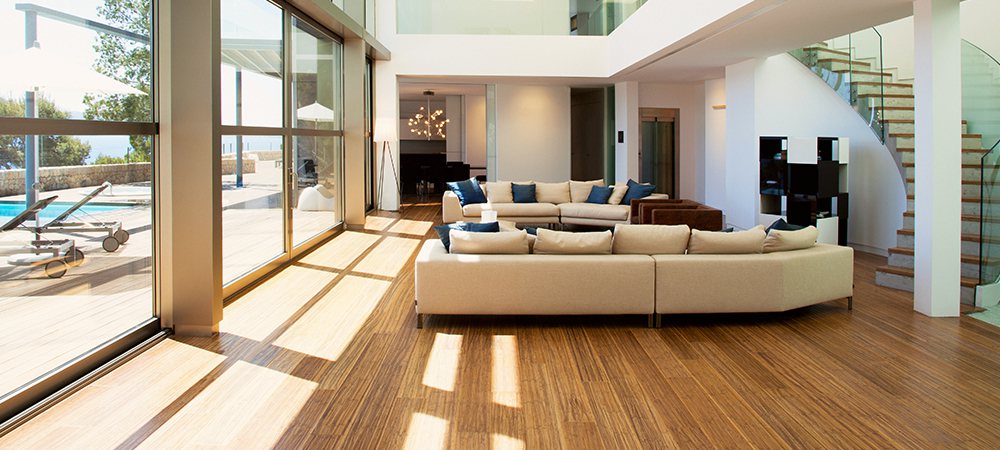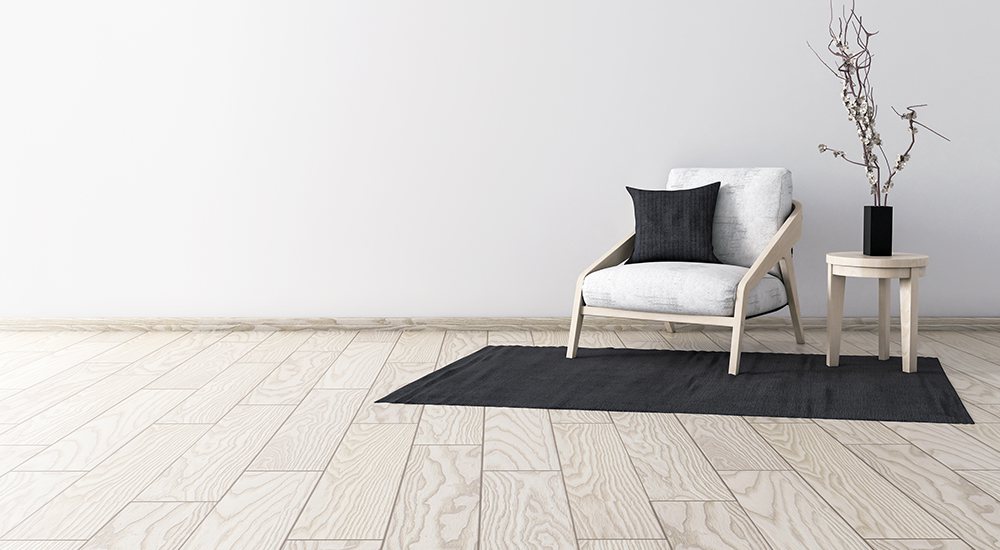White oak floors are some of the most elegant and stylish flooring options available. They don’t require extensive finishing to look beautiful, but you can still customize them to suit your preferences. You’ll agree that they’re not only beautiful, they’re also versatile and practical flooring options. Their aesthetic appeal is also worth noting, and you’ll certainly love having white oak wood for your floors.
However, a minor issue causes most people to be skeptical about white oaks. This problem involves how to keep white oak floors from yellowing. It’s a major source of concern for homeowners who have white oak floors. It’s also one of the primary reasons many people avoid white oak floors.
Nonetheless, you shouldn’t let maintenance doubts keep you from giving your home the elegance it deserves. So don’t worry about how to keep your white oak floors looking great. We’ll provide the essential tips to help you keep your white oak floors shining and looking beautiful for a long time. But before that, let’s examine some basic knowledge about white oak floors.
What You Need to Know About White Oak Floors
The name pretty much gives it away, so you can already tell white oak floors are from white oak wood. Fortunately, white oak wood is native to the eastern part of the North American continent. You’ll typically find them between the Northern parts of Florida and southern Canada. So it’s a pretty popular option in the Canadian wood industry due to the availability of its raw materials.
White oak has a characteristic beige/tan tint, a lighter shade than other oaks. The beige tint presents the white oak like a blank canvas on which you can create any design you like. This speaks to the versatility of white oak and is also one of the reasons for its popularity.
White oak flooring designs are visually adaptable as the neutral tones will work with any colour scheme you choose for your home. Its light hue perfectly complements several types of interior decors. In addition, it can wear a variety of finishes on its neutral tone. So, you can design it to your heart’s content, or you can simply go with its base colour. Then again, you can still stain it with a lighter colour if you want.
Furthermore, the white oaks’ subdued tone is lovely and calming. Using it for your floors sets a mesmerizing foundation for the room, making it relaxing and livable. White oak floors capture the essence of a lifestyle given to serenity and tranquillity. And if you can keep the white oak floors from yellowing, you’ll love every bit of it.
Needless to say, white oak is an excellent option for you to achieve your dream floor. In our opinion, nothing beats using the white oak for flooring in its natural tone. However, you’ll have to pay more attention to its care and maintenance to keep it beautiful for longer.
Speaking of keeping white oak floors longer, How do white oaks lose their elegance? Or, what makes them lose their beauty in the first place?
What Turns White Oak Floors Yellow?

Several situations can cause wood floors to change colouration. Not only white oak floors now, wood floors generally can fade and change colour in the following conditions.
Frequent Exposure to Sunlight
Woods are highly photosensitive, i.e., they react to light. However, they’re more sensitive to sunlight in particular. Trees harvest sunlight for photosynthesis, and have mechanisms that enable them to trap sunlight faster. So, the trees may still retain some of this ability even in timber form. This may be the main reason for the extreme sensitivity to sunlight in white oak floors.
That said, constant exposure to the Ultraviolet rays of sunlight for an extended period will cause a noticeable colour change. You may start noticing the effects in as little as a few months after installing your white oak floor.
Exposure to UV rays will darken the floors, almost like a sunburn effect. The yellowing effect undoubtedly diminishes the elegance of the white oak floors, but you can still get the yellow out of white oak flooring by following some of the tips we’ll share later on in this post.
Using Oil Based Polyurethane for the Floor Finish
The popular opinion indicates that oil-based polyurethane, Watco, Tung oil, and other oil-based varnishes contribute to the yellowing of white oak. Exposure to sunlight also speeds up the process in many cases. However, there are minor differences in specific brands regarding how they cause discolouration in woods.
Nonetheless, the chemicals in oil-based varnishes tend to react with environmental factors in the long run. These reactions often result in discolouration in the wood.
Ageing
Oaks are strong wood species and some of the best flooring materials. Needless to say, they make some of the most beautiful hardwood/ engineered wood floors. However, they’re also subject to ageing; nothing beats time, not even white oak wood. They last very long, but not forever; your white oak will slowly change colours with time.
Please note that your white oak floors will not significantly darken with age to the point of looking like a different wood species. However, it’ll discolour just enough to ruin the beauty of the floor. But not to worry, there are several remedies to counter the effects of ageing and keep your white oak from yellowing. Keep following to find out more.
Related Article: What is Wire-brushed Flooring?
Things You Can Do To Keep White Oak Floors From Yellowing
Like we implied earlier, there are many things you can do to keep your white oak floors from yellowing. Even if there are already signs of discolouration on the floors, you can still restore it to its beautiful state. With appropriate treatment of the white oak, you can maintain its sheen and make the floors last longer. Below are some things you can do to keep your white oak floors looking elegant.
Basic Maintenance Activities
White oak floors require attention and care to keep them from yellowing. You can’t neglect proper maintenance for your white oak floors and hope they magically stay beautiful for long. To keep your floors looking elegant, you need to follow some basic maintenance practices such as the ones below.
- Vacuum the floors as often as possible to keep them free from dirt and dust. Most people underestimate the effects of dust and dirt on their hardwood floors. If you let dirt rest too long on your white oak floors, it can create hard-to-clean stains and contribute to its yellowing.
- Wipe up spills quickly to keep the wood from soaking up liquids. White oak floors take their time soaking up liquids; however, when they do, they’re bad at hiding it. So whenever it happens, you will have a visible stain on your oak floor even if the liquid spilled was only water.
Water can also contribute to yellowing in your white oak as the tannins react with water making it look blackish. So, you need to take extreme care to prevent liquid spills and when they happen, wipe them up ASAP. Of course, you don’t have to worry much about this if you have a sealant coat or other types of varnishes. These provide adequate protection for your hardwood floors. Regardless, don’t leave liquid spills on the floor for long; it’s bad practice.
- If possible, avoid stepping on the floors with your shoes on. By keeping the shoes away, you’ll also prevent trudging mud and other dirt on the hardwood. If you have kids or pets, you want to get them playmats to reduce scratch marks and dents on the planks.
- Use furniture pads under your furniture to prevent marks or stains. Unfortunately, many people never pay attention to the effects of their furniture on their hardwood floors. So they just place the furniture around without using any safety measure to protect the wood surface. While the impact may not be noticeable immediately, it’ll become apparent if you leave it that way for a long time.
- Use the right products for cleaning the hardwood floors. This is because generic cleaning materials may have harsh chemicals that can stain the wood or damage it. So, you should always go for named wood cleaners whenever you set out to wash your white oak floors.
Other Treatment Options
Other ways to keep your white oak floors from yellowing include:
Use a Sealant Coat
Your white oak floors will stain easily if you leave them without a coat. Not only that, but the planks will also feel like raw wood when you step on them. In return, you get to preserve the original look and feel of the wood for a little while. This is the only advantage to leaving your white oak floors without a coat.
However, the main problem with leaving your white oak floors without any coating is you’re practically leaving them unprotected. Without appropriate protection for the planks, even water spills cause a noticeable stain on them, at least until it evaporates. Even worse, oil stains will go right through the wood regardless of your best effort to quickly wipe the floor.
But, when you have a sealant coat protecting your white oak flooring, you don’t have to worry about oil stains. Not only that, the floors will feel silky smooth and rock hard under your feet. The coat will also add to the sheen of the planks, which helps to refract light and reduce photo effects on the wood. And if you use a good quality product, you can also preserve the tone and colour of the wood.
Use Water-Based Polyurethane
Instead of a sealant coat, you can also use a water-based polyurethane as a varnish for your floor. Polyurethane is a polymer that’s useful for a variety of applications. Various industries use it for protective coatings, foam, plastic wheels, insulations and many more. When applied in liquid, it hardens and dries to form a protective moisture-resistant layer on wood surfaces. Plus, it also adds a smooth and lustrous look to the floor.
For years, oil-based polyurethane was the ideal choice of finish for hardwood floors. However, water-based polyurethane is replacing it as one of the best and most popular floor varnishes. The main reason is water-based polyurethane does a better job of preventing discolouration in hardwoods. In the case of white oak floors, it helps to keep the wood from yellowing or fading out.
While both options do an excellent job of keeping out stains, oil-based polyurethane doesn’t offer much to prevent yellowing in white oaks. This is because oil-based polyurethane doesn’t refract UV rays. Then again, there are speculations that the oil amplifies the effects of sunlight on white oak floors.
As an addition, water-based polyurethane is also an environmentally friendly option. It has little to no volatile organic compounds like the gases emitted by chemicals in Oil-based varnishes. These gases can be harmful to both the environment and the people exposed to them. Plus, water-based polyurethane dries faster and provides a clearer finish. So, it’s the best option to retain the tone of your white oak wood.
Bleaching
Bleaching is an excellent option for restoring stained white oak floors to their original hue. It works very well although it may be a bit expensive. The high cost of bleaching is due to the price of the bleaching agent and other materials you’ll need for the job. Nonetheless, it produces excellent results without damaging the grain of the wood when you use it.
Nonetheless, you want to exercise caution when bleaching the white oak floors. You need to avoid taking out too much colour unless you want the white oak to have a lighter hue than its original colouration. To that effect, you can take the following steps when bleaching your white oak floors.
- First, determine the type of bleach you’ll need for the treatment. The three common options are peroxide, chlorine and oxalic acid. All three agents work differently on white oak floors. For instance, peroxide is suitable for lightening the natural wood colour, but it’ll not work well on dye stains. Chlorine is more effective for removing dye stains. And oxalic acid is best suited for tannic acid stains.
- After picking out the appropriate bleaching agent, you can then move to the treatment process. You should begin by washing the wood with denatured alcohol to remove dirt.
- Then remove paint and varnish from the wood using sandpaper or mechanical sander.
- Sweep out the debris after sanding the wood
- Rewash the floor with mineral spirits to remove remaining grease and oil. After that, open the windows to allow proper ventilation in the room.
- Ensure you have all appropriate safety materials on – a pair of tough plastic gloves and safety glass.
- Pour the undiluted bleaching agent into a plastic bucket. Don’t dilute or add anything to the bleaching agent. Use a clean cloth to apply it directly on the wood floor. Ensure each floor area gets a good wipe down to ensure an even effect. If you’re working on a large area, you may want to use a spray gun to spread the bleaching agent more effectively.
- Leave the floor to dry for 6 to 15 hours, depending on how long it takes. Although the time frame is not very important, ensure the floor dries up entirely before proceeding.
- Once the floor is dry, wash the wood one more time with denatured alcohol, then lightly sand the wood to remove bleach from the grains of the wood.
Bleaching effectively keeps white oak floor from yellowing, and it can also restore its original elegance. The process may be expensive and time-consuming, but the results justify the effort.
Things To Note Before Treating White Oak
All the treatment options and maintenance practices discussed above are proven ways to keep white oak floors from yellowing. However, they may not have the desired effects in some cases, or worse, they may have the opposite effect. Therefore, you need to consider some pointers before treating your white oak floors.
First, determine how your wood reacts with different products. For instance, if you intend to apply a clear topcoat, you can first use the product on a small patch of waste cut off of the same wood. Then observe to see how it’ll look with the clear topcoat.
Also, determine if your wood floor needs refinishing or not. You can tell the floor needs a retouching if it has a lot of visible scratches, looks dark and dingy, or has a noticeable discoloration.
Related Article: Pros and Cons of Wire Brushed Hardwood Floors
Final Thoughts
You can do many things to keep your white oak floors from yellowing. First, you need to stay diligent with basic maintenance activities. Then you can opt for other treatment options to better protect your white oak floors. Regardless, ensure to put in the necessary effort to maintain the elegance of your white oak floors and keep them beautiful.
Speaking of maintaining elegance, there are various stylish white oak floors options fit for your home. LV Flooring will deliver top-quality white oak flooring that’ll retain its original colour for a long time. Shop with us today! You can simply check out our online store to view different white oak flooring options.


